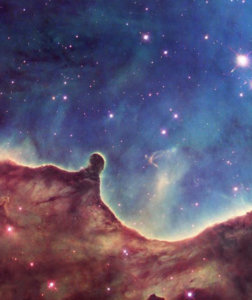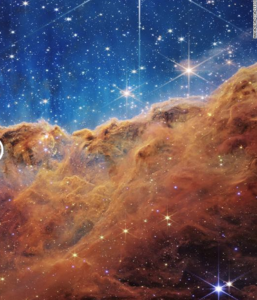 A new space telescope was launched on Christmas Day 2021. It is NASA’s largest and most powerful space science telescope since Hubble launched on April 24, 1990, and the largest in the world. The first images from the James Edwin Webb massive telescope were released on July 11th, 2022, and are giving us magnificent images.
A new space telescope was launched on Christmas Day 2021. It is NASA’s largest and most powerful space science telescope since Hubble launched on April 24, 1990, and the largest in the world. The first images from the James Edwin Webb massive telescope were released on July 11th, 2022, and are giving us magnificent images.
James Webb Space Telescope
The new telescope is named after the former NASA director during the Mercury, Gemini, and Apollo programs, which put the first man on the moon. They nearly didn’t name it after him because during his leadership a large number of gays were fired from NASA. Correlation doesn’t provide validation, and later investigations declared that it would be “an Injustice” to blame him.
Multinational Effort
The James Webb Space Telescope (JWST) has 20 countries participating in its enormous cost of $10 billion—the main funders have been the USA, EU, and Canada. It was launched on the 25th of December 2021 on an Ariane 5 rocket from Kourou, French Guiana, which was the only launch vehicle large enough to house this large disassembled JWST. It arrived a month later in January 2022 in a halo orbit configuration beyond the moon—called an L2 Lagrange point.This Lagrange point is 3.9 times further away from the earth than the moon and its halo orbit is directly away from the sun from the earth. This is an incredibly complicated orbit configuration. You will see why.
Light times from the moon to Earth are about 1.3 seconds and from the sun about 8 minutes to travel 93 million miles (1 AU). JWST is away from the sun and the earth about 0.01 AU from the Earth. JWST has a light time of 5 seconds to Earth. Because of its size, JWST had to be reassembled robotically in space. Here are a couple of images that were first shared with the public on 11 July 2022 with much more exciting detail than from Hubble. Here are comparison telescope image examples.


EDWIN HUBBLE JAMES EDWIN WEBB
Space Telescope Details
Each of the 18 mirrors has six actuating stepping motors to keep them focused with accuracies of nanometers (nanometer = a billionth of a meter). In the opening photo, you can see the five heat shields as well as the 18 mirrors. The images we are seeing from it of the heavens are amazing. It has a 40-degree look angle and can get images in all directions every half year, as it does its halo orbits above the earth and away from the sun nominally synchronous with the earth’s orbit period of one year.
The JWST halo orbit is highly unusual. Most all satellites orbiting the earth are in one of three configurations: LEO (low-earth orbiting), MEO (medium-earth orbiting), and GEO (geosynchronous earth orbit), with orbit periods of about 2 hours or less, 12 sideral hours, and 24 sidereal hours, respectively.
Sputnik was an LEO, as is Hubble, and as is the International Space Station (ISS) with an orbit period of 93 minutes. Russia, which has provided many scientists for the ISS, has announced its intention to withdraw from the ISS not before 2024 but before 2028. The navigation satellites (GPS, GALILEO, GLONASS, and BIDOU) are MEOs. A new worldwide communication system is now being planned around LEOs. There are about 200 GEOs at the equatorial belt—orbiting synchronous with the earth’s spin period of one sidereal day and are used for worldwide communications, as they appear stationary as they orbit the earth at the same rate as the earth spins on its axis.
The altitudes of the LEOs, MEOs, and GEOs, are about 0.3, 4.2, and 6.7 earth radii. The 6.7 earth radii distance of the GEOs makes them not useful for voice communication because of the time delay. Hence, they are planning LEO configurations of satellites for worldwide (no cell towers) communications.
My Interest and Background
The JWST is particularly interesting to me for several reasons. The above picture was taken at NASA, Goddard, Beltsville, Maryland. I have been there many times for meetings, and they have hydrogen-maser atomic clocks there as well as at John Hopkin’s, nearby, which is the control location for JWST. Northrop Grumman was the principal contractor. I was invited to give a talk at Northrop Grumman not too long ago. They showed me the highly accurate gyro they had developed for Hubble. Since we lived in Boulder, Colorado, for 32 years, we knew Ball Aerospace well, and several of our friends and neighbors worked for Ball. Ball Aerospace designed and built the 18 mirrors for JWST.
My first trip to NASA Goddard was in 1964 when the IEEE and NASA sponsored a special symposium to deal with the problem of characterizing precise timing sources—like quartz-crystal oscillators and atomic clocks. Atomic clocks were new at that time. Quartz-crystal oscillators were the main timekeepers before atomic clocks, and they were plagued with long-term frequency variations called flicker noise. Mathematically, the classical variance had no convergent value for flicker noise, so this was a major problem in trying to characterize the frequency variations in quartz-crystal oscillators. Jim Barnes had developed a special autocorrelation function that mathematically converged for flicker noise. He and I presented a paper at the symposium with a solution to the flicker-noise problem. It was extremely well received.
The next year, Jim went on to do his Ph.D. thesis using this special autocorrelation function and wrote an algorithm to use an ensemble of quartz-crystal oscillator clocks calibrated by the NBS primary cesium-beam frequency standard. The NBS started keeping official time for the USA using his algorithm, which he programmed using an IBM 360 computer.
That same year, I did my master’s thesis, using this special autocorrelation function along with a powerful book Jim introduced me to by Sir James Michael Lighthill, Fourier Analysis and Generalized Functions. Page 43 of Lighthill’s book gave me the mathematical information I needed to characterize flicker noise and the several other different noise processes occurring in time and frequency metrology.
Since atomic clocks were new, a series of comparisons began in the Fall of 1965 and on through to 1970, at NBS in Boulder, to compare the best atomic clocks in the world. Bob Vessot brought his hydrogen maser from Varian in Boston and later one from Smithsonian Astrophysical Observatory in Cambridge, MA. Len Cutler and Lee Bodily brought their HP 5060-A commercial cesium atomic clock, Harry Peters brought his hydrogen maser from NASA Goddard. And we, at NBS, had the primary cesium-beam frequency standard for the USA and the official time, AT-1 time scale algorithm. Jim had been made Section Chief and had given me the responsibility for generating time; that is when I wrote AT-1 to replace his algorithm, as we moved from quartz-crystal clocks in the ensemble to atomic clocks. A twelve-authored paper came out of these comparisons, and later comparisons followed. The metric used to compare all the clocks was the square root of the Allan variance–though Don Halford, who was Section Chief after Jim, gave the metric that name later. With improvements by my several outstanding colleagues, AT-1 is still generating official time for the USA today.
Putting God into The Equation
I am intrigued with the cleverness of the JWST, and the images we are seeing are astronomically astounding. I see this focused energy on the part of so many costing an enormous budget of $10 billion to figure out how the universe came into being without God.
Most of their astronomical assumptions are based on the Big Bang theory, which has been proven false; yet they ignore the falsification data and move on with what I call the “Big Bank” theory.
For me, the truths I am sharing in my new book, Time and Eternity, the End-Times and Beyond Revealed, leave in the dust, all that they have and will share. As soon as we put God in the equation then truth and light across all spectral densities emerge with enormous promises for this life and beyond. Satan is so subtle in hiding what is most important for us in our mortal journey on this exciting spaceship called Earth. Because of the exciting results coming from JWST, they are already planning the next generation. The world says, “Look to the science!”
I was invited to be a member of the International Astronomical Union (IAU) because of my work with millisecond pulsars and atomic clocks. I know the ego of most of those folks in the IAU, and humility is not their calling card. Alma said it well, “Look to God and live” (Alma 37:47).
I am so happy that my work has gotten international attention that I can share God’s love; over a hundred nations visit my book’s website, www.ItsAboutTimeBook.com, and with about a hundred thousand visits per year. I believe my new book will be a game changer–being printed this Fall–Time and Eternity, the End-Times and Beyond Revealed–Giving hope and purpose to a very troubled world.
David W. Allan
Photo: CC Flickr